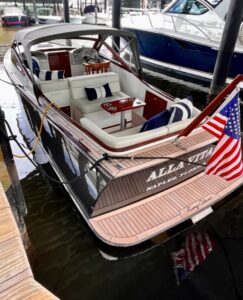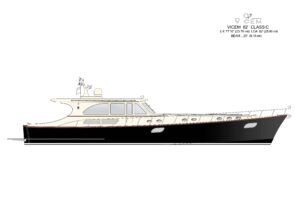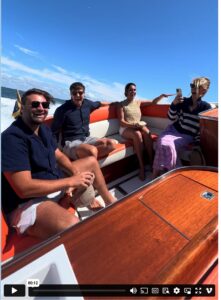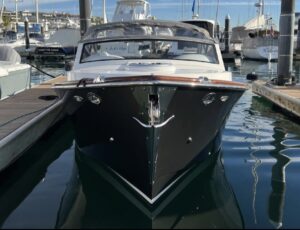Mayday!
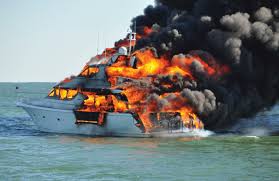
Last summer I did a solo delivery of a friend’s 45’ boat from Sag Harbor to Newport. A few miles off Fisher Island she caught fire, and I sent out the first (and, I hope, the last) Mayday call of my life. It all ended well enough (meaning no one was hurt) but I thought it time to share the story with my loyal readers. Perhaps it can help you in preparing your boats (and minds) for the coming season.
She was your basic twin engine down-east style yacht, and I’ve done this trip many times, alone and with friends, day and night, in good weather and bad. She was a well-equipped and well-maintained boat, but did not, notably, carry a life raft.
I was heading east at 11 am at a speed of 24 knots, with light winds and two foot seas. It was the proverbial weekday milk run, and the only other boats I saw were a couple of fishing boats drifting through The Race, perhaps three miles away.
I’ll say upfront that I love running boats by myself. Even on Gypsy, my 40’ trawler, I’m most at peace when it is just the two of us:
Maybe that’s why I can be a little safety-obsessed (my kids’ friends refer to me as Safety Dave). When I am moving a boat alone, 90% of the time I’m wearing my own personal mini-ditch kit. I’d like to say that’s the case 100% of the time, but it just isn’t.
That kit consists of my Offshore inflatable PFD. I like this one, as it is rugged, fairly light, and not too uncomfortable:
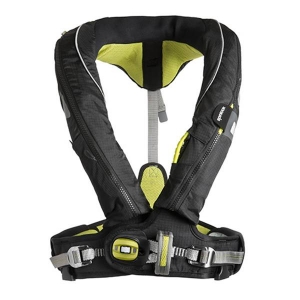
There was a product recall a few years ago on this model, due to defective strap design. If you own one, make sure it’s been checked out.
To it I’ve attached this Mustang Utility Pocket. It hangs easily at waist level, and I usually forget it’s even there:
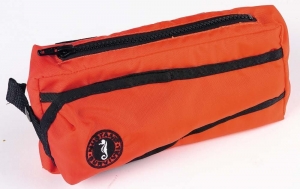
Into it I tuck this mini-EPIRB (properly registered with NOAA):
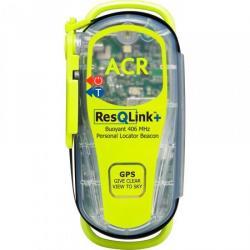
The Coasties who saved my ass that day told me that 25% of owners don’t register their new EPIRB’s, and 75% of those who do neglect to update it as their boats and contacts change over time. Enough said about that….
Also in there is a sharp knife, and a fairly recent signaling innovation – a compact laser flare. Day or night, it can get someone’s attention from two miles away:
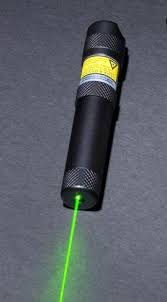
So equipped, I was cruising along at 3,000 RPM, when suddenly the RPM on the port engine dropped to 600 RPM. I heard no reason for this – no cough, bang or break. What follows is my best recollection of the exact sequence of events over the next 48 hours.
+ 5 seconds – I remember muttering to myself “Well, that’s not good.”
+ 8 seconds – I put both engines in neutral, and began to check off possible reasons. I glanced at the fuel gauges, which showed half full. Then I remembered I’ve been stranded a time or two due to faulty gauges, and I kicked myself for not checking the engine room’s fuel sight tubes before departing Sag.
+ 12 seconds – I turned off both engines, thinking a restart might cure the problem.
+ 15 seconds – Dense, oily black smoke billowed through the enclosed helm area. I was shocked at how quickly my visibility was reduced to under 12 inches. I leaned forward to check the GPS Plotter, and began to cough.
+ 20 seconds – I grabbed the VHF mic (pre-set to Channel 16, but not by me). I was grateful that the new Standard mic had a GPS display right in the handset.
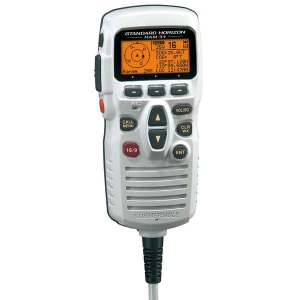
I announced a Mayday and my position, and with my other hand began to feel around for the manual Halon Fire Suppression switch. I was kicking myself that I didn’t know where it was.
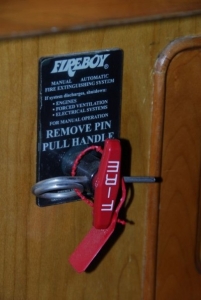
+ 30 seconds – The Coast Guard answered my Mayday call, asking for vessel name. I didn’t pick up the mic to answer, and kept feeling around for the Halon switch. Coughing more, I found I could no longer see the plotter through the smoke. I had the (weirdly calm) thought “I’ll give it twenty more seconds. Then I’m going to have to jump overboard.”
+ 35 seconds – With a loud whoosh,the automatic fire suppression system fired. It took me a moment to identify the sound, as I had completely forgotten about the automatic trigger. Within seconds the smoke cleared, and I knew that everything was going to be OK. Then I saw the that the manual Halon switch was nowhere near where I expected it to be.
+ 40 seconds – I answered the Coast Guard’s call, and told them I was now in no immediate danger. They said I’d have a rescue boat alongside in twenty-five minutes.
+ 1 minute – I went out to the cockpit to take some deep breaths. I thought about opening up the engine room hatch and taking a peak, but then remembered my Coast Guard Six-Pack license training –
Whatever you do, don’t reintroduce oxygen into an engine room after the suppression system fires. Everything will just flare right up again!
+ 10 minutes – A large ferry boat stopped fifty yards away. Dozens of passengers looked down at me. The Captain called me on the VHF. I said all was under control, and they could proceed on their way. They refused, telling me that commercial rules required them to stand by until the Coast Guard arrived. I realized, happily, that if I had jumped overboard these guys would have fished me out even before the Coast Guard arrived.
+ 25 Minutes – I saw the Coast Guard rescue boat coming towards me from several miles away, and I flashed my laser flare at them. When she pulled up, I saw she was crewed by four Coasties – three men and a woman. Their average age was no more than 24 years old. I was pleased that they said they could see my laser flare from over a mile away! Two of them stepped aboard my boat, and set up tow lines. One said “We heard your Mayday. You sounded very calm.” Indeed, I will say that through this entire episode I remained calm and clear-headed. You’ll see below I paid for it all later.
+ 30 Minutes – A rather beat up private marine salvage boat arrived, and exchanged a series of dirty looks with the Coasties. There was no love lost between any of the parties. They follow us for most of the tow back to Long Island, clearly unhappy about missing out on their salvage fees. I made a mental note to research the rules of salvage. I’ll cover this in a future post on The Fog Warning.
+ 10 hours – Late that night I took a car ferry back from CT, making my way home. That’s when I become aware that some sort of delayed shock has set it. I noticed for the first time that my clothes smell badly of smoke. Fellow ferry passengers clearly were aware of it. Then I found that a real and uncontrollable tremor had set up in both of my hands. And finally, I noted that I had begun compulsively telling my story to complete strangers. All in all, an unsettling trip home.
+ 48 hours – My hands stop shaking. The fire department inspection in port revealed that the fire was electrical in nature.
Now, eight months later, here are my thoughts and observations on all that happened. I look forward to your take on it as well.
What I did right:
- I was well equipped for this emergency, and believe I would have easily survived going overboard if the automatic Halon system hadn’t kicked in. Since I did not have the time or visibility to locate the boat’s PFD’s and signaling gear, I’m quite pleased to have been wearing my mini-ditch kit. If I did jump, the water temp was reasonable, and I’m a good swimmer (my normal pool routine is a 45-minute mile, three or four days a week). Even if I had drifted away from the boat in the strongly running tide, I could have easily stayed afloat until rescued by either the Ferry or the Coast Guard, with the possible help of the EPIRB and the laser flare.
- I was well trained. The Fire Safety module of the CG six pack license stuck with me. If I had opened up the engine room hatch, I’m sure a full abandon ship situation would have followed.
- I kept my head. A lifetime of thoughtful time on the water became useful, as did the hundreds of barroom war stories I’ve heard from friends, clients, and delivery captains.
What the boat did right:
- She was well-equipped. The Halon system did its duty, and if I had done a better inspection before departing I would have known where its manual switch was, saving valuable time and damage.
- I’ve become an enormous fan of GPS displaying VHF handsets. They are not just a gimmick. When time and vision is short, they really can be a life saver.
What I did wrong:
- I was new to the boat. I should have done a complete walkthrough before departing. Beyond the manual Halon switch, I didn’t even know where the PFD’s were. This is inexcusable.
- Almost a month later I realized that I had completely forgotten about the red DSC distress button on the VHF. Using it would have saved valuable time. I am embarrassed to say that I wasn’t even really sure about how this feature worked. Needless to say, I later studied the manual carefully.
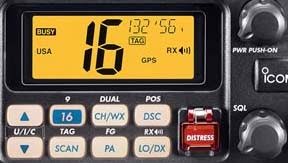
- On Gypsy I keep a survival suit:

And a small valise-style life raft:

Even after the events of this story, I’m very unlikely to pack them aboard for a late-summer forty-mile trip to Newport. But maybe I should?
Beyond that, loyal readers, you tell me….
Safety Dave


